When I first started welding, wire-feed welders were among the first I learned on and there were two different wires used: MIG and flux-cored wires.
The first question I had was, what’s the difference? Then I asked if one was better or if one was cheaper. You get the idea, I had lots of questions about the two options, just like most users.
So, if you’re new to welding and have similar questions, you came to the right place. In this article, we’ll cover the good and the bad, as well as where to use either of these two popular welding processes.
Quick Overview
MIG vs Flux-Core Comparison Table
| MIG | Flux-cored | |
|---|---|---|
| Setup/Learning curve | Moderate | Moderate |
| Wire Cost | ✅ $$ | ⛔ $$$ |
| Requires Gas Tank | ⛔ Yes | ✅ No |
| Operating Cost | $$ | $$ |
| Surface prep | ⛔ Bright white metal is best | ✅ Works through paint, rust, and dirt |
| Wind | ⛔ Indoor, Less than 5 MPH | ✅ Outdoor, Up to 35 MPH |
| Bead Appearance | ✅ No slag, little spatter | ⛔ Slag & spatter |
| Post clean Up | ✅ Very Little | ⛔ Slag & Spatter Cleaning |
| Thin stock | ✅ Down to 24 ga. | ⛔ 1/8 or thicker |
| Thick stock | ⛔ Acceptable with enough power | ✅ Good penetration up to 3/8in. |
| Cast iron | ⛔ Possible, but weaker weld | ✅ Better penetration, stronger than MIG |
| Aluminum | ✅ Cleaner than stick | ⛔ Possible but messier |
| Mobility | ⛔ Harder with gas tanks | ✅ Easier without gas tanks |
Flux-Cored Wire
Pros
- Easy to set up and learn
- Works in windy, outdoor conditions
- Better penetration handles thick stock well
- Affordable
- Tolerates some paint, rust, and dirt
- Welds cast iron and galvanized steel well
- Portable
Cons
- Produces slag and splatter that requires cleaning
- Aluminum welds are not possible
- Will not work on thinner stock without blowing through
Solid MIG Wire
Pros
- Simple to use, pull the trigger and weld
- No slag, less spatter, cleaner than flux-cored
- Handles thin metal well
- Solid wire is less likely to tangle or “birdnest” coming off of the spool
- Solid wire costs less per pound compared to flux-cored wire
- Can produce clean, professional aluminum welds
Cons
- A bit harder to set up for a weld (need to set gas flow rate)
- More expensive when gas and other costs are added to the wire cost
- Needs clean, bright white prep
- Wind blows away shielding gas, even light breezes can be a problem
- Not a good choice for cast iron
- Gas tank makes less portable than flux-cored
Flux-Core vs. MIG Welding – The Similarities
An obvious similarity, both flux-cored and MIG welding involves feeding a spool of wire automatically to the welding torch.
This can reduce the need to constantly replace your consumable electrode, which you need to do when stick welding.
The wire acts as an electrode with both types of wire. The wire electrode is consumed during the weld, hence the need to continuously feed wire to the torch.
So, both wires are vital as they carry current, support the welding arc, and supply the filler material for your weld.
While you will find dedicated MIG and flux-cored welders, many MIG units can weld using both MIG and flux-cored wire.
That’s because the process of using a consumable wire electrode is very similar for both types of wire, except for a significant difference we will discuss in a bit.
Related read: Arc Welding Explained: What is it? & How Does it Work?
Also, both wires can weld aluminum, steel, and stainless steel, making both types versatile, although in some cases, one will be preferable, as we will cover in the next section.
The basic setup for gas metal arc welding (“GMAW) or metal inert gas (“MIG”) welding is shown below.
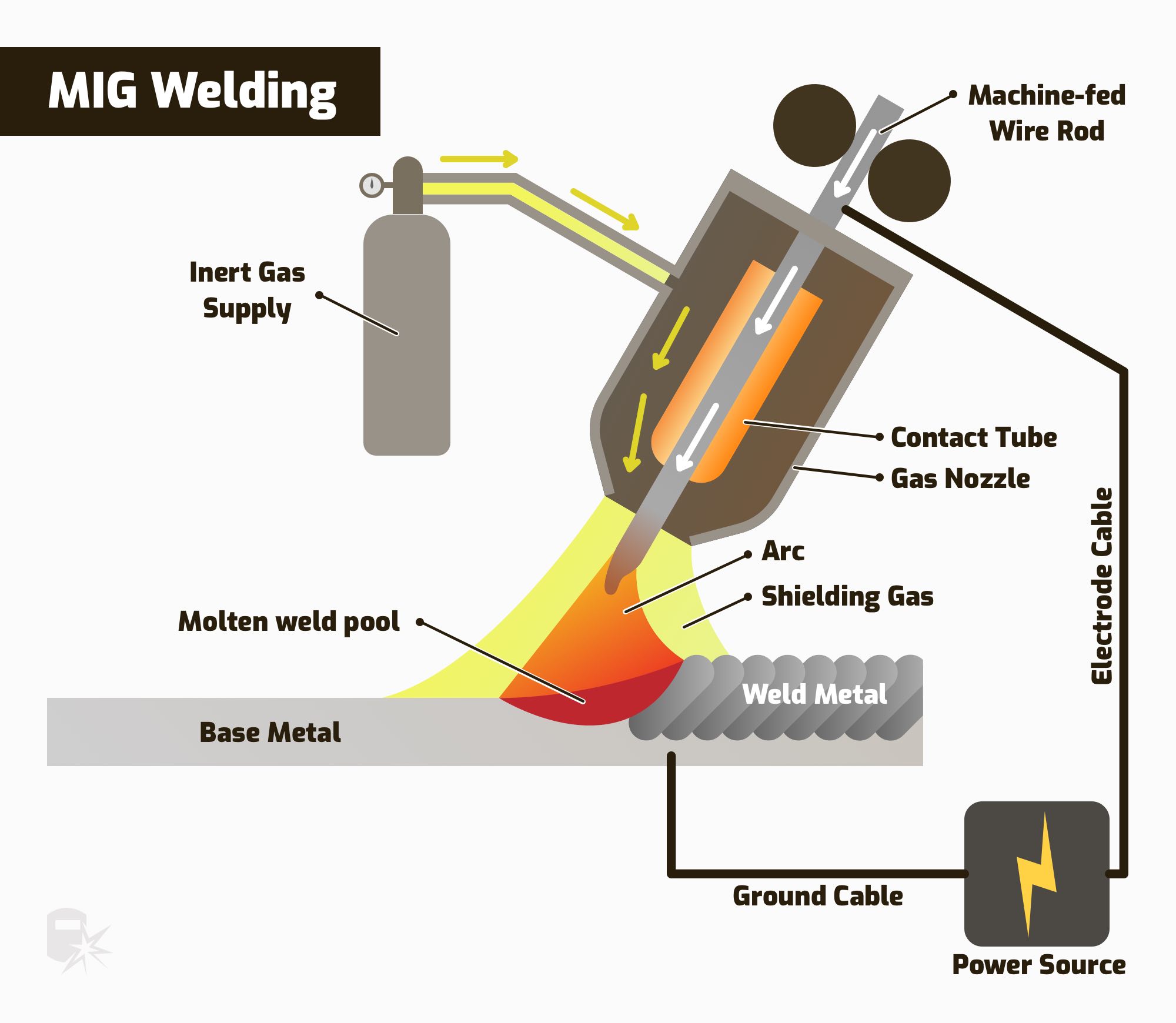
© weldguru.com – Image usage rights
For comparison, below is an illustration of the flux-cored arc welding (“FCAW”) process.
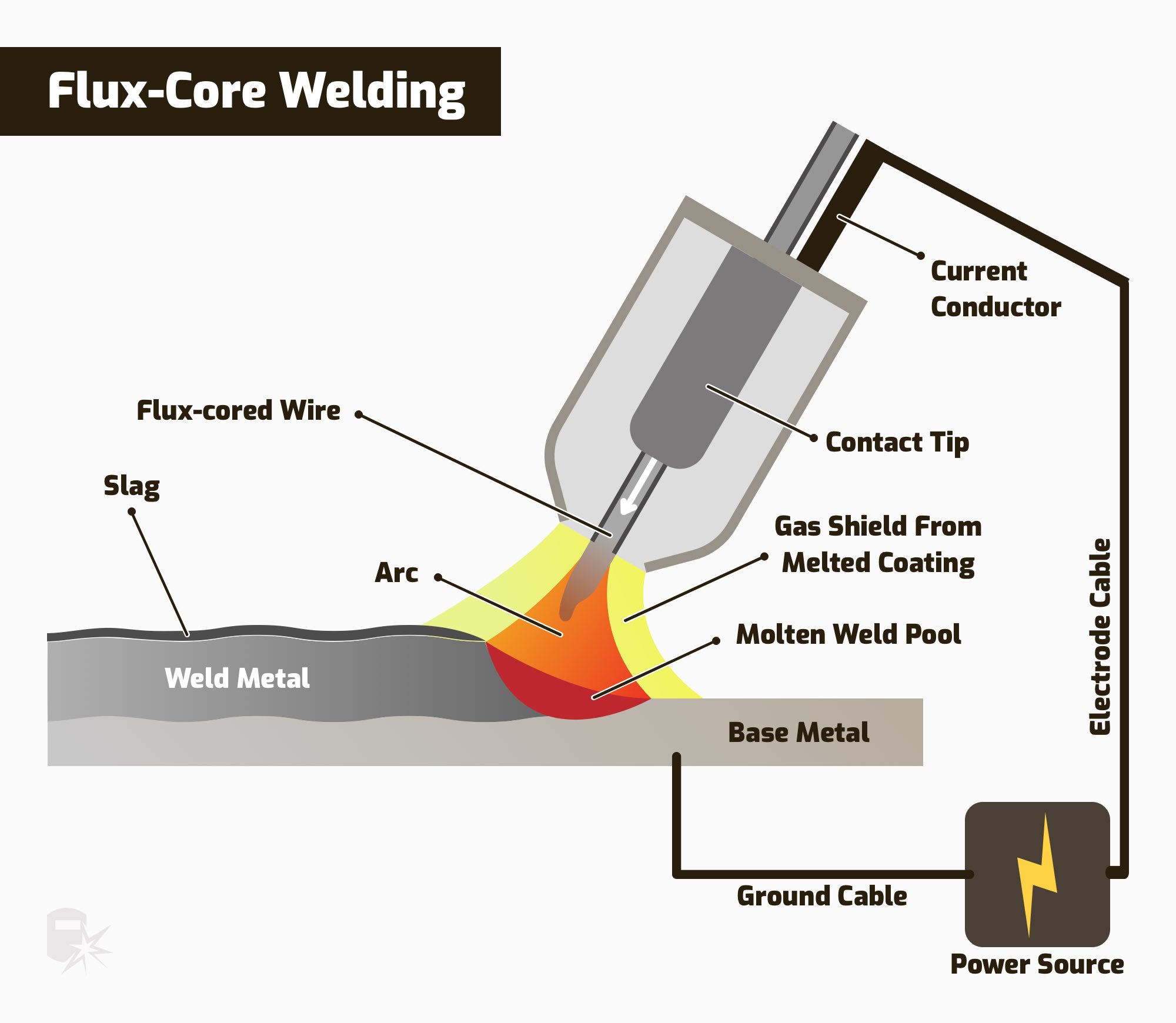
© weldguru.com – Image usage rights
Flux-Core vs. MIG Welding – The Differences
Those who looked carefully at the diagrams of both processes will notice they are quite similar. But not 100%.
The main difference between flux-core and MIG welding is that flux-core welding does not require a shielding gas which makes it more portable.
This also makes flux-core more suited to welding in windy conditions. The self-shielding flux-cored wire provides the shielding gas when burned.
There are more differences but let’s break these down below.
Shielding Gas
The most obvious difference, the MIG process uses a tank of gas. This gas is fed to the torch along with the wire. It’s very important for a successful MIG weld.
That’s because it shields the weld puddle from the gasses in the air, which can react with your hot weld and cause defects.
When flux-cored welding, you face the same “air” contamination problem. But this form of welding shields the weld using flux contained inside a hollow core inside the wire. Hence the name “flux-cored” wire.
The flux reacts with the weld’s high heat at the torch and releases a protective gas. It also produces a shell of slag, that “crusts” over the weld. So, a tank of compressed gas is not needed.
Related: What is Flux used for In Welding?
This ability to produce its own shielding gas earned flux-cored welding the nickname “gasless MIG.” But as we just explained, it is not gasless. It generates a shielding gas to protect the hot weld, and the “gasless” moniker refers to the fact that you don’t need a gas tank.
There are flux-cored wires that use both gases from a tank and the additional protection provided by flux. This is referred to as dual-shielded welding.
For this reason, you often find flux-cored wires categorized as dual-shielded or self-shielding. But self-shielding is the most common.
MIG and flux-cored both bring advantages and disadvantages. For instance, the MIG shielding gas can be changed by changing out the tank.
That can be useful when you weld a wide range of metals. You have more control. Aluminum, for example, works best with pure Argon.
So, MIG welding then means you have to have tanks of compressed gas on hand, and possibly more than one if you work with more than just steel. Tanks are heavy and need to be handled to prevent toppling over. Plus, you need accessories like hoses and regulators.
With a flux-cored wire, you normally don’t need gas tanks, but you need to have the right alloy wire and flux core mixture for the weld at hand.
This involves keeping various wires if you weld varying metals. Storage can be an issue, bringing us to the flux-cored wire construction.
Read more: Shielding gas for MIG welding – What to use
Wire Construction
We already touched on the construction differences of both wires. MIG wire is solid. But the flux-cored wire is in essence a hollow tube filled with flux and some other important additives.
A cross-section would look like the diagram below:
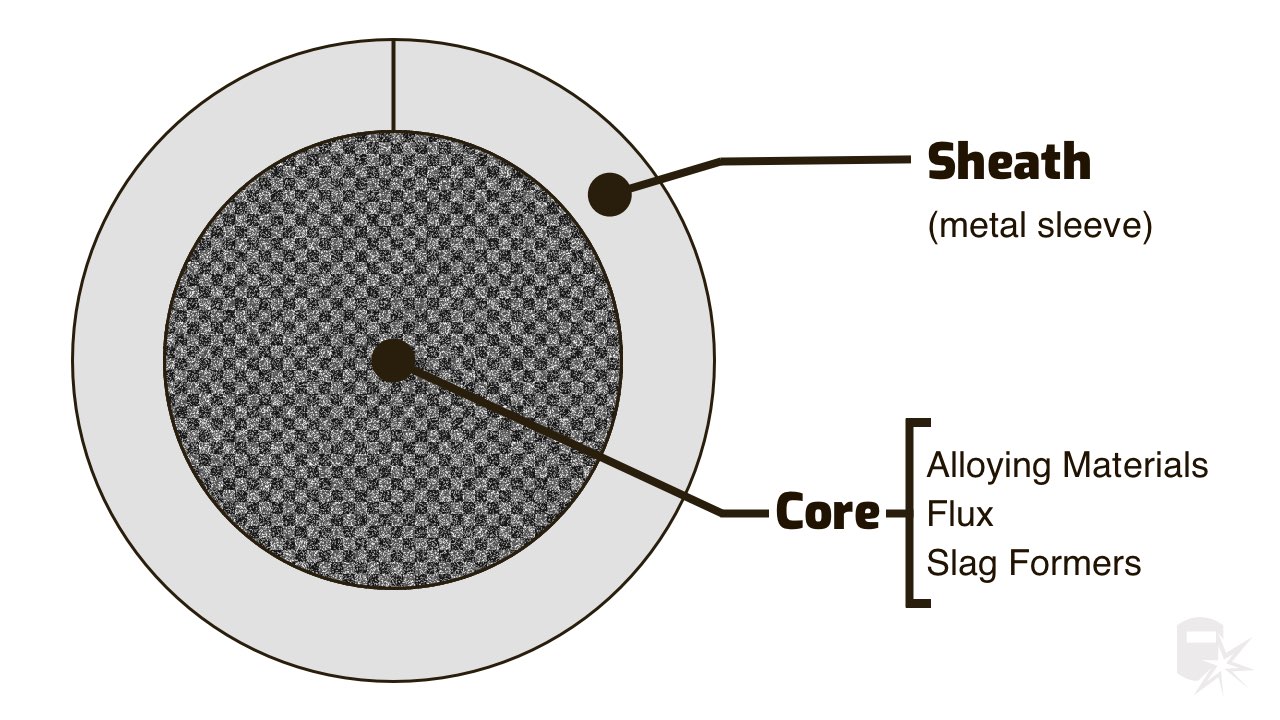
© weldguru.com – Image usage rights
For flux-cored welding, you must buy a specific wire with the metal alloy and the right core compounds, depending on the weld you need. This can get complicated, so you may have many different wires to handle and store.
Also, some flux-cored wires need cool, low-humidity conditions, or they can absorb moisture and go bad. So, there are a variety of flux-cored wires you may need to keep on hand and store properly if you rely on the flux-cored wire only in your shop.
Polarity
Look closely at the diagrams for each process, and you’ll see MIG and flux-cored welding have different polarities on the torch. The MIG torch electrode is set to positive, while the torch electrode is set to negative for a flux-cored wire.
So, if you switch from one type of wire to the other, you must change the polarity. The correct polarity is needed for quality welds, or you risk burn-throughs or excess spatter.
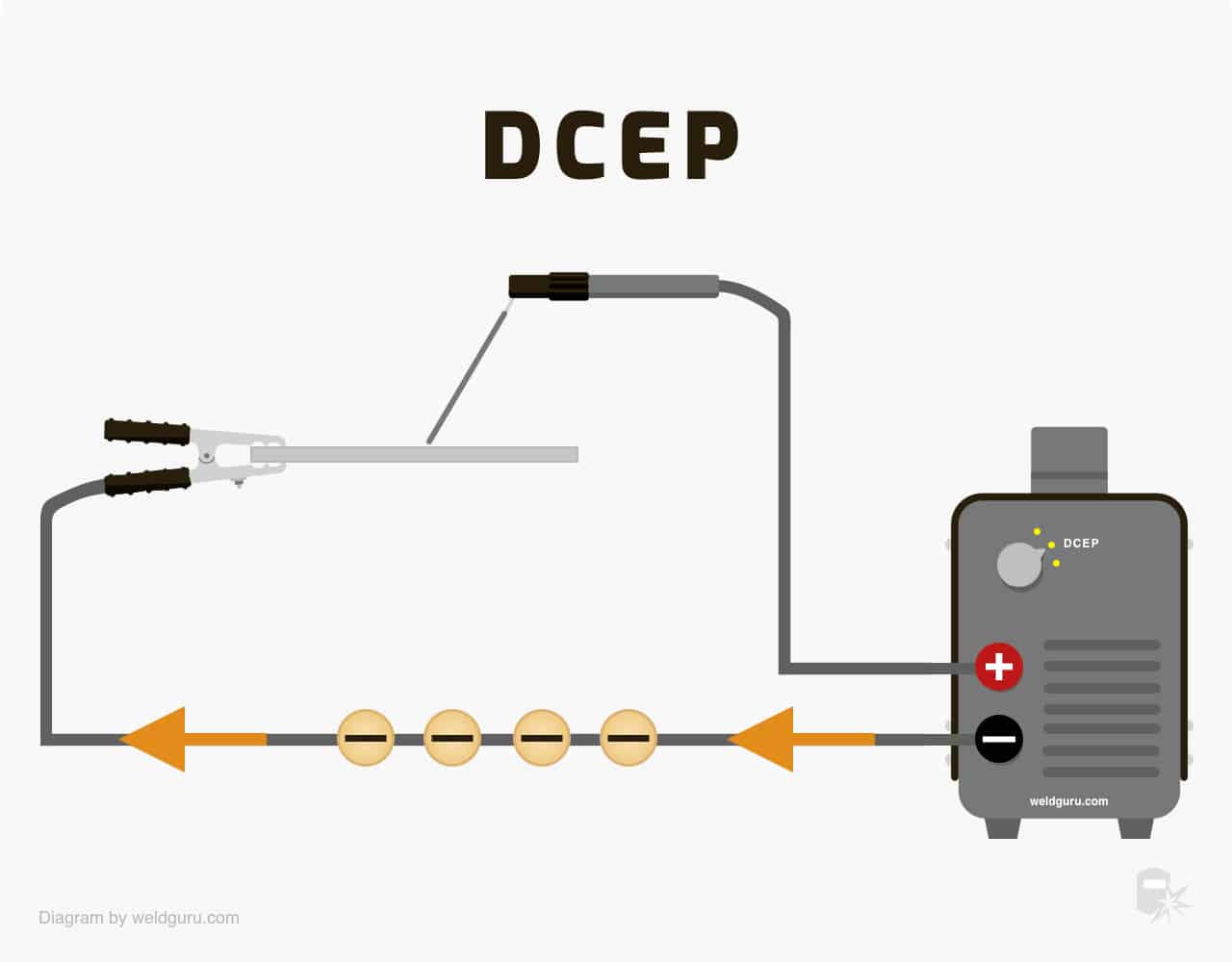
© weldguru.com – Image usage rights
As mentioned earlier, with MIG welding, the torch is positive, and the work is negative. That means the current jumps from the workpiece to the wire.
This setting is called direct current electrode positive (“DCEP”) and it concentrates more heat in the workpiece. It is also sometimes called reversed polarity.
In flux-cored welding, the electrode is often negative, and the workpiece is positive. The current jumps from the wire electrode to the workpiece.
But be aware, some flux-cored wires do require a DCEP arrangement, so you must pay attention to your polarity when doing flux-cored welding.
The electrode negative arrangement is called direct current, electrode negative (“DCEN”), or sometimes just straight polarity. You get more heat in the electrode with DCEN.
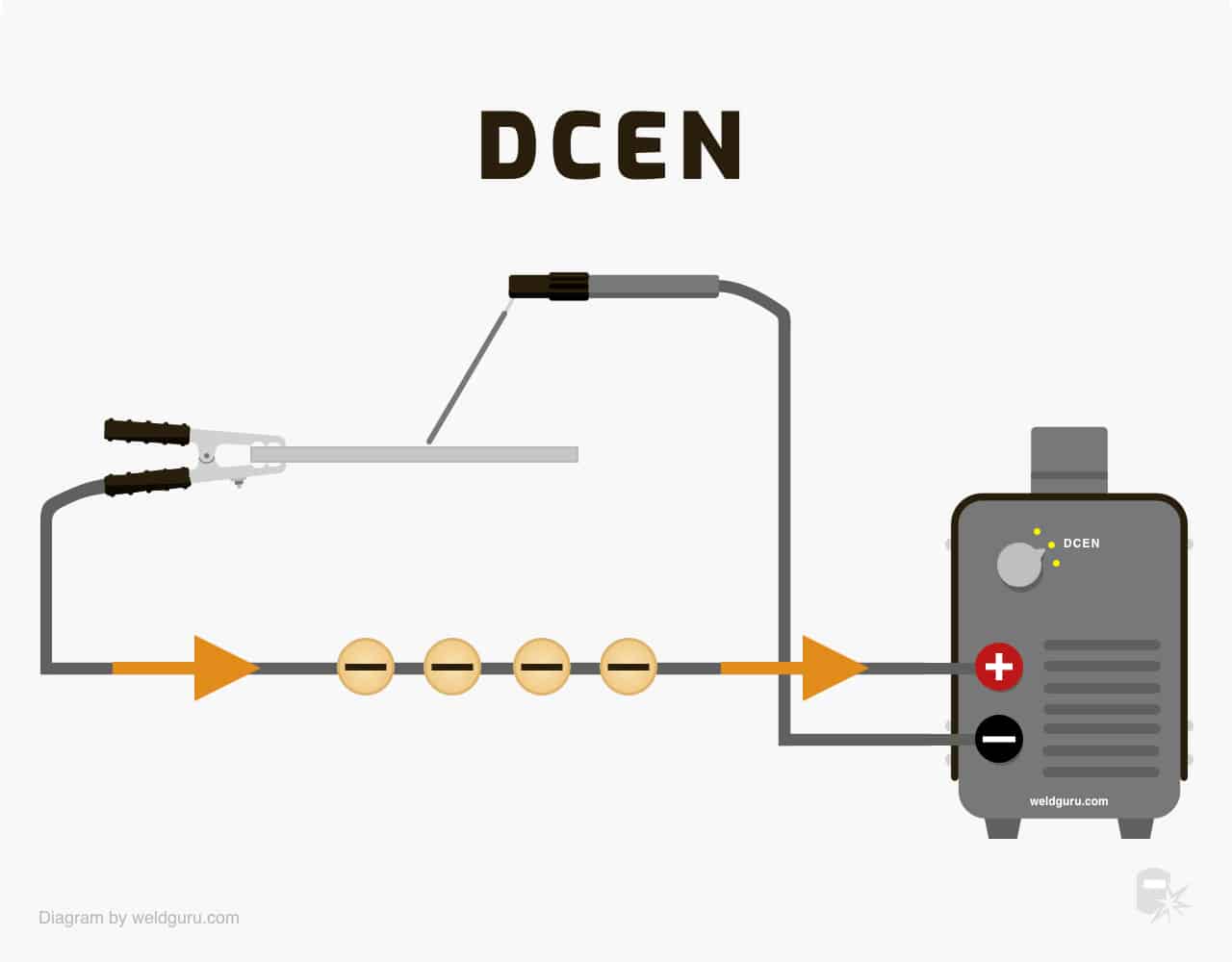
© weldguru.com – Image usage rights
In short, the current direction impacts how and where heat is concentrated during a weld. DCEP results in more heat in the base metal and better penetration. DCEN results in more heat in the electrode and less penetration.
Therefore, welds created with DCEN result in lighter penetration, with more heat in the electrode. So, DCEN welds are usually wider and shallower than the welds produced by DCEP. For this reason, DCEN is often used for thinner metal or parts with a poor fit-up.
The other benefit of DCEN is the resulting higher heat in the electrode is perfect for flux-cored. Remember, the flux and additives in the core of flux-cored wire need heat to work. The EN polarity places the high heat in the right place for the flux inside the wire to work.
Polarity changes can be an issue for some MIG welders. Not all of them can swap polarity. If they don’t, they can not run most flux-cored wires.
If you want to run both types of wire, you need to buy a MIG unit that can easily change the torch polarity.
Filler Material
With flux-cored wired, there are additives in the core along with the flux. This is an important difference between the flux-cored and solid wires.
Technically, they provide different filler materials. While not a huge issue, there are some things to know.
The wire “shell” alloy and flux mixture in the center of an FCAW wire are designed to work with a specific metal. This allows the reacted flux to float to the surface as slag, and cover the bead.
The resulting bead is a very similar alloy to the base metal being welded. But it is different.
For example, some grades of flux-cored wire have higher manganese, which makes the weld unsuitable for multiple passes. This is because the manganese makes the weld more susceptible to work hardening and multiple passes can make the joint brittle or cause it to crack.
You will find flux-cored wires rated for single or multiple passes for the reasons just stated. If you need to make multiple passes, be sure to use a flux-cored wire rated for it.
With MIG wire, it is solid metal, so the weld filler material is “purer” compared to FCAW. It is, therefore, more forgiving and suitable for multiple passes. Plus the alloy is often identical to the metal being welded.
Strength
Following up on the filler material discussion, you might think MIG welding results in a stronger weld. But in actual use, both of the MIG and flux-cored wires make very similar strength welds. With one very important caveat, that they are done right.
That means using the right wire for the base metal being joined, correct welder settings, proper technique, etc. needs to be employed for the wire being used. But if the joint is properly welded, there is not a significant difference in strength between the two wires.
One of the notable differences in strength is found with cast iron. Flux-cored wire does result in stronger welds with better penetration in this case. For this reason, cast iron is usually best done using FCAW.
Penetration
At some point, you will hear that flux-cored wire penetrates better. But is that really true?
The answer is not as simple as you may think. Since the heat is concentrated in the FCAW electrode, you get more focused “heat,” which means it penetrates differently than GMAW.
This means for the same amperage, you get better penetration with flux-cored wire. This can be important if you are welding thicker pieces and pushing your welder. With flux-cored wire, that extra penetration may be needed if you have your welder is set to max amps for the job.
But both flux-cored wire and MIG wire penetrate well. You will need a bit less juice with a flux-cored wire, and some users like to note this by saying that you get more bang for your buck with FCAW.
Another advantage to the flux-cored wire using a few less amps, you can use a smaller generator on remote jobs to get the penetration you need.
MIG vs. Flux Core Welding – Which is Better?
It is almost impossible to say one wire is better than the other, but in certain situations, one wire does become a better choice.
Some of the more common situations you may encounter are:
Surface Preparation
Anyone who has laid even a few MIG beads knows that GMAW is not forgiving when it comes to rust, dirt, or debris. A pristine, bright white metal surface is best and there are no cutting corners with surface preparation.
But with FCAW, one of the other benefits of the flux used is that it reacts with and removes metal oxides and dirt. It has the ability to cut through the contamination.
So, flux-cored has an advantage if you are in situations where the base metal will have some rust or dirt. For this reason, flux-cored wire is often used in places like shipyards where getting the metal to bright white is difficult.
Weld Appearance
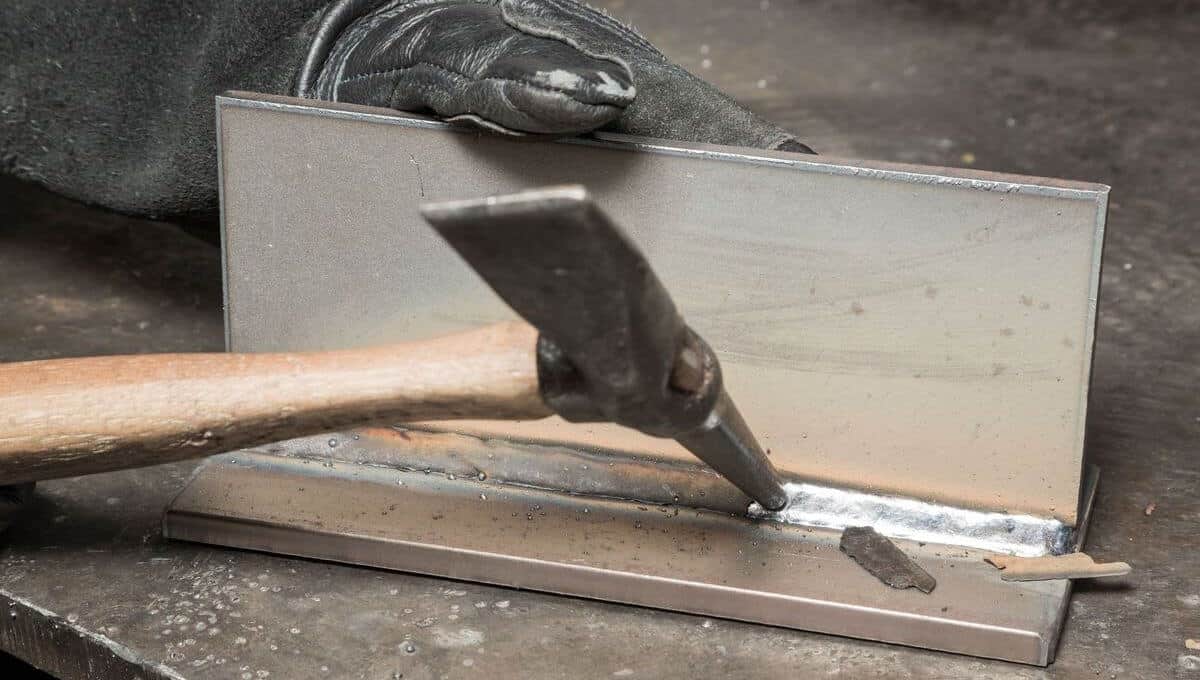
This is one advantage that is pretty obvious, literally. As the flux reaction produces slag, there is some spitting and sputtering, or spatter.
With MIG wire, there is very little spatter, and the resulting GMAW weld is the cleaner-looking option. When clean, pretty welds are needed, MIG is the best choice.
Outdoors
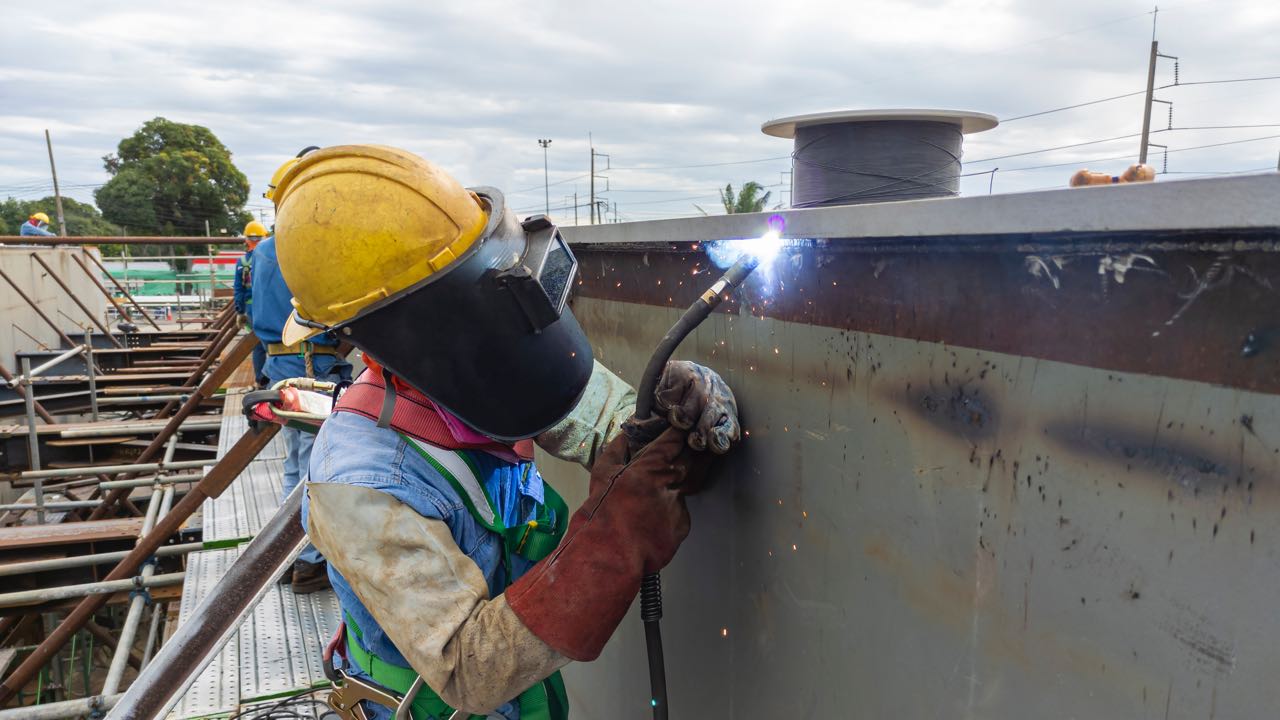
The shielding gas pumped to the torch with the MIG process allows for welds free of slag and with little to no spatter. But if there is a wind of 5 MPH or higher, the shielding gas is blown away, and the hot puddle is exposed to harmful gasses in the air.
So, outdoors where there is wind, flux-cored wire is a better choice. The nature of how the shielding gas is formed combined with the slag encapsulation protects the molten puddle in winds up to 35 MPH.
Thin Stock
The MIG process shines compared to the flux-cored wire when it comes to thin stock. If you weld things like autobody pieces, MIG welding is less likely to burn through.
Also, if the piece is to be painted, the cleaner weld (i.e., no slag) is a plus. Slag can make it difficult for paint to bond. If you plan on leaving the welds exposed, the cleaner MIG welds again will be your best choice.
Costs
The flux-cored wire does cost more per pound compared to solid MIG wire. But the cost comparison is a bit more complicated.
Flux-cored becomes cheaper when you add in MIG’s cost for the tank of gas, higher upfront cost of a MIG welder, higher amps, etc. Of course, this will vary depending on what welder you buy, which wire you use, the thickness welded, etc., but in general, MIG is a bit more expensive.
Cast Iron
As we touched on earlier, the flux-cored wire gets penetration and develops stronger weld with cast iron. For this reason, cast iron is usually welded using a flux-cored wire.
Note: FCAW cast iron is best suited for automated welding of thick cast iron parts, not for manual casting repairs.
Aluminum
MIG’s clean welds are a decided advantage on aluminum. The reduced spatter and absence of slag make for a better-looking weld. Given that much aluminum work is left exposed, the cleaner MIG weld is preferred.
Also, fluxed-cored wires that work in a wire-feed welder don’t actually exist. You will get results with an internet search, but a little more research will reveal these are for brazing, or in fact, they are solid aluminum wires.
For aluminum, MIG is your best and only option, but you may need to buy a spool gun.
Galvanized Steel
If you weld galvanized steel, you will first need to grind off the galvanizing. You cannot weld through it.
But with flux-cored wire, it has the ability to cut through the galvanizing and form a good weld. For galvanized steel, flux-core is the better choice.
Pros vs Cons – Recapped
Flux-Cored Wire
Pros
- Easy to set up and learn
- Works in windy, outdoor conditions
- Better penetration handles thick stock well
- Affordable
- Tolerates some paint, rust, and dirt
- Welds cast iron and galvanzied steel well
- Portable
Cons
- Produces slag and splatter that requires cleaning
- Aluminum welds are not possible
- Will not work on thinner stock without blowing through
Solid MIG Wire
Pros
- Simple to use, pull the trigger and weld
- No slag, less spatter, cleaner than flux-cored
- Handles thin metal well
- Solid wire is less likely to tangle or “birdnest” coming off of the spool
- Solid wire costs less per pound compared to flux-cored wire
- Can produce clean, professional aluminum welds
Cons
- A bit harder to set up for a weld (need to set gas flow rate)
- More expensive when gas and other costs are added to the wire cost
- Needs clean, bright white prep
- Wind blows away shielding gas, even light breezes can be a problem
- Not a good choice for cast iron
- Gas tank makes less portable than flux-cored
Quick FAQs
Is flux core as strong as MIG?
Both MIG and flux-cored wires make very similar strength welds, and if the joint is properly welded, there is not a significant difference in strength between the processes.
The only notable difference in strength is found with cast iron. Flux-cored wire does result in stronger welds with better penetration in this case. For this reason, cast iron is usually best done using FCAW.
Is MIG welding with gas better than flux core?
If you are working indoors, MIG welds will have the advantage of being more visually appealing and will have no slag to chip off. However, if you are working outside, then flux core welding will be better as it can withstand windy conditions.
Can any MIG welder use flux core?
Most MIG welders are designed to be compatible with flux core wire, however, some MIG welders may not mention this. If your MIG welder does not say, it can most likely weld with a flux core wire with a few changes to the machine.
The main settings to change are the polarity from positive to negative and changing the drive roller so it does not damage the softer flux core wire.
Wrapping It Up
When first learning about welding, many of us hear about MIG’s clean beads that even novice welders can do. So, when I first started welding, I naturally thought MIG solid wire was a better choice than flux-cored.
But I was wrong. Flux-cored wire offers many strengths, and it is the better choice for certain situations. Knowing when and where the solid or flux-cored wire is a better choice makes you a better welder. So, it is worth your time to learn.
A brief summary might go something like this. Thin stock is best done with solid MIG wire. But when working outdoors in windy conditions, you are better of with flux-cored wire.
Welding cast iron or galvanized steel, again go with the flux-cored wire. But if you need to weld aluminum, then you need to use the MIG welder with solid wire (and possibly a spool gun).
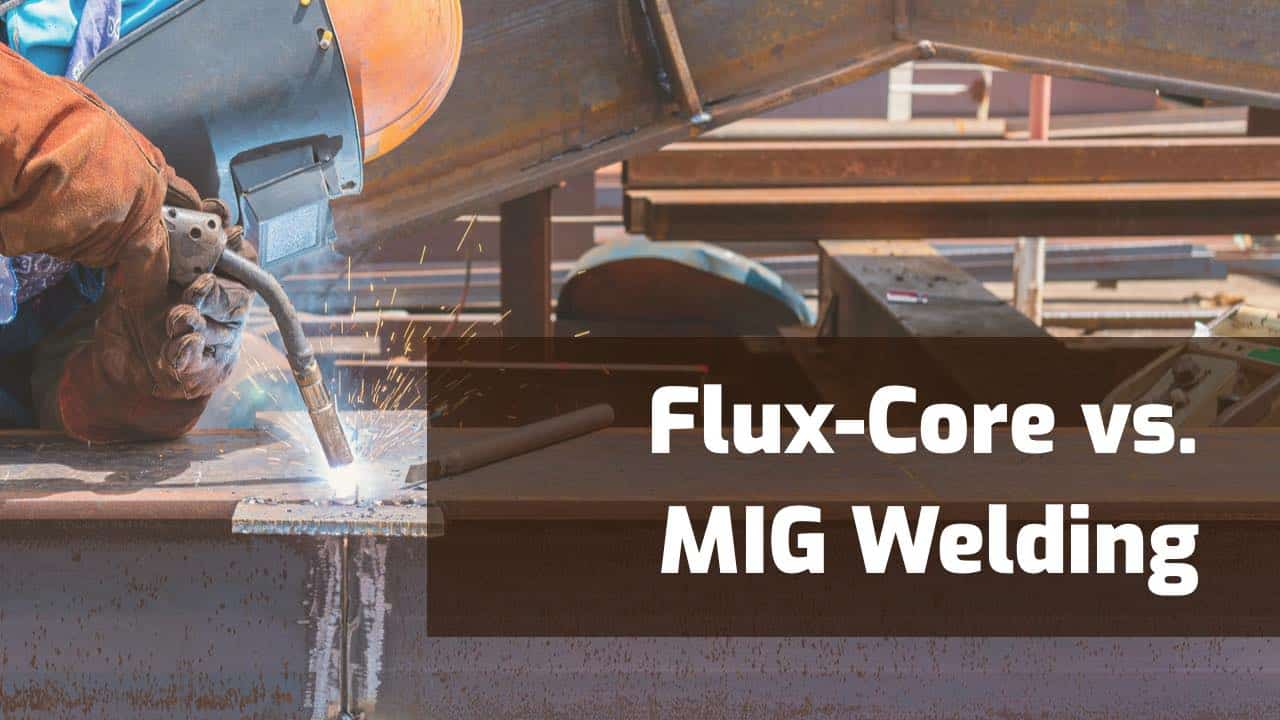
Wow, this is such an exhaustive article, i haven’t even read it all and am all ready sure it is all i need to get going. Thank you for taking the time to write it, you deserve a lot more comments already.
s.
When I use mig with gas will I then have to connect the handle to + and with flux connect the handle to -.
Please tell me, thanks
Hi – yes.
When MIG welding, the cable to gun should connect to positive (+) output terminal and cable for work clamp should connect to negative (−).
The opposite should be used for flux-core welding.